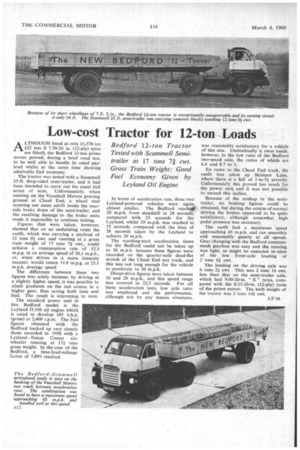Low-cost Tractor for 12-ton Loads
Page 54

If you've noticed an error in this article please click here to report it so we can fix it.
ALTHOUGH listed at only £1,576 (or E22 less if 7.50-20 in. (12-ply) tyres are fitted), the Bedford 12-ton prime mover proved, during a brief road test, to be well able to handle its rated payload whilst at the same time showing admirable fuel economy.
The tractor was tested with a Scammell 25-ft. drop-sided semi-trailer, and it had been intended to carry out the usual full series of tests. Unfortunately, when running on the Vauxhall Motors proving ground at Chaul End, a wheel stud securing nut came adrift inside the nearside brake drum of the semi-trailer, and the resulting damage to the brake units made it impossible to continue testing.
Figures that were taken, however, showed that on an undulating route the outfit, which was carrying a payload of 12 tons Of cwt. and running at a gross train weight of 17 tons 7i cwt., could achieve a consumption rate of 12.3 m.p.g. at an average speed of 26.1 m.p.h., or, when driven in a more leisurely manner, would return 11.6 m.p.g. at 25.1 m.p.h. average speed.
The difference between these two figures was solely because, by driving at a slightly higher speed, it was possible to climb gradients on the test course in a higher gear, thus saving both time and fuel. The result is interesting to note.
The standard power unit in this Bedford model is the Leyland 0.350 oil engine which is rated to develop 105 b.h.p. (gross) at 2,400 r.p.m. The fuel figures obtained with the Bedford backed up very closely those recorded in 1958 with a Leyland Eaton Comet sixwheeler running at 171 tons gross weight. In the case of the Bedfdrd, a time-load-mileage factor of 5,899 resulted.
In terms of acceleration rate, these two Leyland-powered vehicles were again almost similar. The Bedford reached, 20 m.p.h. from standstill in 24 seconds, compared with 22 seconds for the Leyland, whilst 29 m.p.h. was reached in 55 seconds, compared with the time of 58 seconds taken by the Leyland to achieve 30 m.p.h.
The standing-start acceleration times for the Bedford could not be taken up to 30 m.p.h. because these figures were recorded on the quarter-mile dead-flat stretch of the Chaul End test track, and this was not long enough for the vehicle to accelerate to 30 m.p.h.
Direct-drive figures were taken between 10 and 20 m.p.h., and this speed range was covered in 22.5 seconds. For all these acceleration tests, low axle ratio was employed and the performance, although not by any means vivacious,
was reasonably satisfactory for• a vehicle of this size. Undoubtedly it owes much, however, to the low ratio of the Bedford two-speed axle, the ratios of which are 6.4 and 8.7 to 1.• En route to the Chaul End track, the outfit was taken up Skimpot Lane, where there is a hill of 1-in-51 severity. Unfortunately this proved too much for the power unit and it was not possible to ascend this incline.
Because of the mishap to the semitrailer, no braking figures could be obtained, but during the course of normal driving the brakes appeared to be quite satisfactory, although somewhat high pedal pressure was necessary.
The outfit had a maximum speed approaching 45 m.p.h. and ran smoothly and reasonably quietly at all speeds. Gear changing with the Bedford constantmesh gearbox was easy and the steering was light, as might be expected in-view of the low front-axle loading of 2 tons 61 cwt.
The loading on the driving axle was 6 tons 21cwt. This was 2 tons 16 cwt. less than that on the semi-trailer axle,. which had 9.00-20-in. " X " tyres, compared with the 8.25-20-in. (12-ply) tyres of the prime mover. The kerb weight of the tractor was 2 tons 141 cwt.
J.F.M.




















































































































